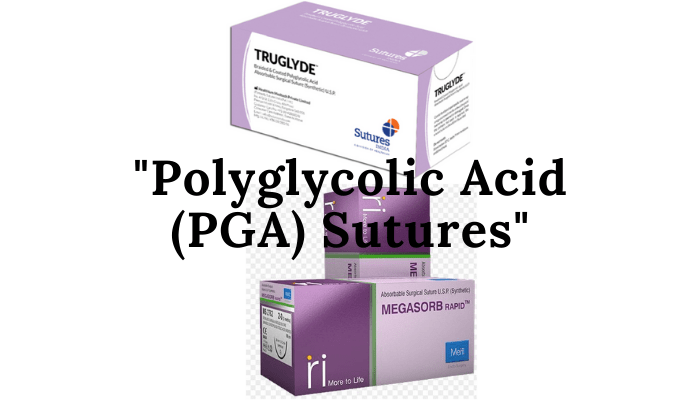Composition
Polyglycolic acid suture / PGA suture is a synthetic, non-collagenous, braided multifilament, homo polymer of glycolic acid. It is smooth, sterile, strong and rapidly absorbable suture composed of 100% glycolide coated with non-toxic biocompatible material i.e. polycaprolactone and calcium stearate.
Uncoated PGA suture have more / significant tissue drag and may cut delicate / soft / friable tissues. PGA is coated with L-taurine and L-lysine which makes thread smooth and soft. It is also treated/ coated with polycaprolactone and calcium or magnesium stearate (equal parts less than 5% w/w) and finally sterilized with EO (ethylene oxide). Coating makes suture smooth and decreases tissue drag but results into relatively and slightly poor knot security and require extra throws (firm kntting). Coated / dyed sutures are violet in color. Coated PGA sutures cause minimal tissue drag and ensure easy passage through tissue.
Tissue reaction
It is non-antigenic, non-pyrogenic, soft and flexible, stimulates comparatively less tissue reaction (grade-1, slight reactivity).
Tensile strength
PGA sutures lose their 25% tensile strength after two weeks, 50% after 3 weeks and 75% after 4 weeks of implantation and are completely absorbed in 60 to 90 days. Retains 50% knot tensile strength up to 21 days. Absorption takes place with loss of mass of the suture.
Characteristics
The material has outstanding greater tensile strength, less reactive, more predictable loss of tensile strength and absorption, in-vivo inertness and excellent handling properties, smooth tie down/ good knot security in comparison to chromic catgut but loss of strength is more rapid making it unsuitable for use in slow healing tissues of tendons, ligaments etc.
Fig: Truglyde – Coated PGA Suture
Absorption
Unlike catgut absorption of polyglycolic acid sutures is accomplished by hydrolysis and digestion, and not by phagocytosis.
Indications
Polyglycolic acid sutures are useful for a wide variety of surgical procedures like closure of clean wounds, general closure, subcutaneous sutures, intradermal sutures, abdominal surgeries / gastro-intestinal tract Surgeries, thoracic surgeries, orthopaedic surgeries, hysterectomy surgeries (obstetrics/gynaecology) and ophthalmic surgeries. PGA sutures exhibit superior tensile strength in comparison to polyglactin suture or vicryl but still supplemental layer of non-absorbable sutures in areas of high tension (abdomen, chest, joints etc) is advised on skin.
Contraindications
More rapid absorption in alkaline pH or environment like urinary bladder makes them unsuitable for cystorrhaphy or cystotomy closures / urinary tract surgeries. Like catgut PGA sutures are also not suitable for use in cardiovascular and neurological surgical procedures or tissue approximation.
Patient status like old age, malnourishment, delayed wound healing and anaemia may result into fast/rapid absorption of polyglycolic acid sutures.
Though use in urinary and biliary tract surgeries is warned but if used may act like a nidus and cause calculus formation. Superficial placement of sutures during subcuticular closure may result into induration associated with absorption process.
Don’t use in the case of known history of hypersensitivity with PGA sutures or any of its components i.e. polyglycolic acid, calcium stearate and polycaprolactone .
PGA suture are multifilamentous in nature which may increase the risk of infection and enhance existing infection. Polyglycolic acid sutures are also not recommended in the areas where extended approximation is required for tissues under stress.
Adverse reactions
PGA sutures incites minimal tissue reaction. Still a transient local irritation or inflammatory reaction can be seen at the wound site. Erythema and induration during absorption of subcuticular sutures can be seen due to foreign body response.
Sizes
These PGA sutures are available in various gauze sizes (6-0 to 4) and lengths (45 cm – 90 cm), non-needled or needled with different types of needles in varying shapes (1/4 circle, 1/2 ciricle, 3/8 circle, micropoint spatulated, round body, reverse cutting, taper cutting, cutting) and sizes (8 mm – 22 mm). Double armed sutures are also available. It comes in aluminium foil packing wrapped in paper pouch laminated with polyester film.
Handling & Storage
It is advisable to handle suture carefully and avoid crushing or crimping. Reshaping of needle may result into breakage of needle.
These sutures should not be kept for reuse and should not be re-sterilized. It may result into suture dehiscence due to loss of tensile strength and contamination of surgical site or transmission of infection from one patient to another.
Storage is recommended at 10oC-35°C away from moisture and direct heat.
Examples
Dexon II, Truglyde, Megasorb, Petcryl etc.
Polyglycolic Acid Fast Suture
PGA fast sutures (eg. Megasorb rapid) are also available for short term use. Like normal polyglycolic acid sutures PGA fast is also absorbable, braided and coated synthetic suture which provides predictable and reliable absorption. It loses 50% knot tensile strength within 6-8 days and complete mass absorption takes place within 42 days.
These sutures have good knot security and easy to handle.
Indicated only in the conditions where short term use in superficial soft tissue approximation of the skin and mucosa (where 7-10 days wound support) is required.
Fig: Megasorb Rapid – PGA Fast absorbing suture
FAQs
No. Vicryl is not 100% PGA. Vicryl is polyglactin which contains 90% Polyglycolic acid while PGA/Dexon suture contains 100% polyglycolic acid.
Polyglycolic acid is a synthetic polyfilament suture material derived from 100% of glycolic acid. It is available uncoated (Dexon S) or coated (Dexon II) with polycaprolate, a copolymer of glycolide and ε-caprolactone.
Yes. Polyglycolic acid suture is absorbable and it is biodegradable.
PGA or Polyglycolide or poly (glycolic acid) is an absorbable, polyfilament, synthetic suture material.
Dexon sutures are absorbable, braided multifilament homo-polymer sutures made up of 100% polyglycolic acid or PGA.
Dexon suture thread is an absorbable braided multi-filament suture.
